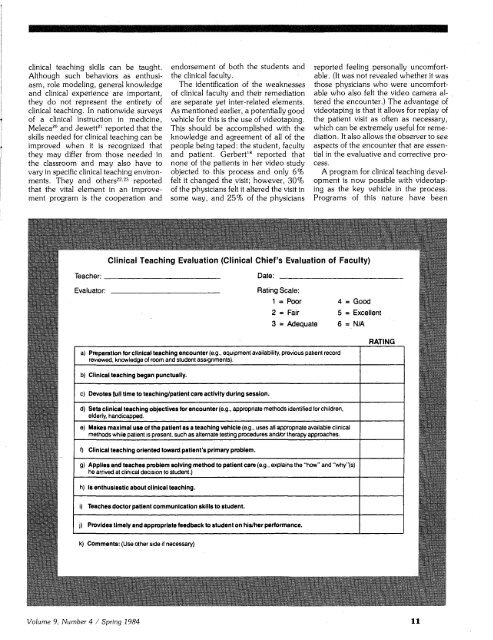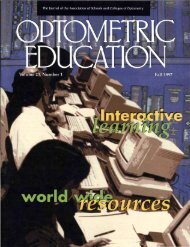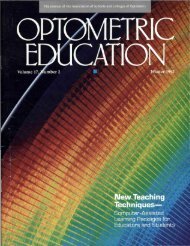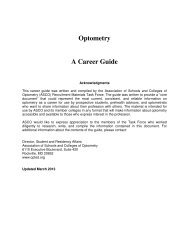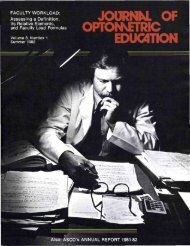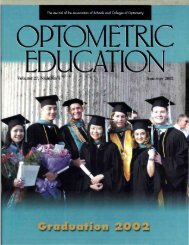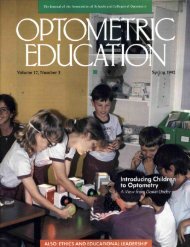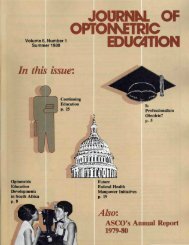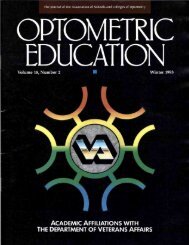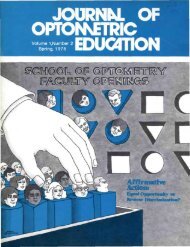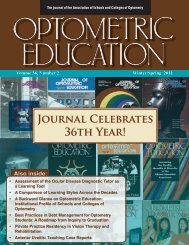Spring 1984, Volume 9, Number 4 - Association of Schools and ...
Spring 1984, Volume 9, Number 4 - Association of Schools and ...
Spring 1984, Volume 9, Number 4 - Association of Schools and ...
You also want an ePaper? Increase the reach of your titles
YUMPU automatically turns print PDFs into web optimized ePapers that Google loves.
clinical teaching skills can be taught.<br />
Although such behaviors as enthusiasm,<br />
role modeling, general knowledge<br />
<strong>and</strong> clinical experience are important,<br />
they do not represent the entirety <strong>of</strong><br />
clinical teaching. In nationwide surveys<br />
<strong>of</strong> a clinical instruction in medicine,<br />
Meleca 20 <strong>and</strong> Jewett 21 reported that the<br />
skills needed for clinical teaching can be<br />
improved when it is recognized that<br />
they may differ from those needed in<br />
the classroom <strong>and</strong> may also have to<br />
vary in specific clinical teaching environments.<br />
They <strong>and</strong> others 2223 reported<br />
that the vital element in an improvement<br />
program is the cooperation <strong>and</strong><br />
endorsement <strong>of</strong> both the students <strong>and</strong><br />
the clinical faculty.<br />
The identification <strong>of</strong> the weaknesses<br />
<strong>of</strong> clinical faculty <strong>and</strong> their remediation<br />
are separate yet inter-related elements.<br />
As mentioned earlier, a potentially good<br />
vehicle for this is the use <strong>of</strong> videotaping.<br />
This should be accomplished with the<br />
knowledge <strong>and</strong> agreement <strong>of</strong> all <strong>of</strong> the<br />
people being taped: the student, faculty<br />
<strong>and</strong> patient. Gerbert 18 reported that<br />
none <strong>of</strong> the patients in her video study<br />
objected to this process <strong>and</strong> only 6%<br />
felt it changed the visit; however, 30%<br />
<strong>of</strong> the physicians felt it altered the visit in<br />
some way, <strong>and</strong> 25% <strong>of</strong> the physicians<br />
reported feeling personally uncomfortable.<br />
(It was not revealed whether it was<br />
those physicians who were uncomfortable<br />
who also felt the video camera altered<br />
the encounter.) The advantage <strong>of</strong><br />
videotaping is that it allows for replay <strong>of</strong><br />
the patient visit as <strong>of</strong>ten as necessary,<br />
which can be extremely useful for remediation.<br />
It also allows the observer to see<br />
aspects <strong>of</strong> the encounter that are essential<br />
in the evaluative <strong>and</strong> corrective process.<br />
A program for clinical teaching development<br />
is now possible with videotaping<br />
as the key vehicle in the process.<br />
Programs <strong>of</strong> this nature have been<br />
Clinical Teaching Evaluation (Clinical Chief's Evaluation <strong>of</strong> Faculty)<br />
Teacher: _<br />
Evaluator:<br />
Date:<br />
Rating Scale:<br />
1 = Poor<br />
2 = Fair<br />
3 = Adequate<br />
4 = Good<br />
5 = Excellent<br />
6 = N/A<br />
a) Preparation for clinical teaching encounter (e.g., equipment availability, previous patient record<br />
reviewed, knowledge <strong>of</strong> room <strong>and</strong> student assignments).<br />
RATING<br />
b) Clinical teaching began punctually.<br />
c) Devotes full time to teaching/patient care activity during session.<br />
d) Sets clinical teaching objectives for encounter (e.g., appropriate methods identified for children,<br />
elderly, h<strong>and</strong>icapped.<br />
e) Makes maximal use <strong>of</strong> the patient as a teaching vehicle (e.g., uses all appropriate available clinical<br />
methods while patient is present, such as alternate testing procedures <strong>and</strong>/or therapy approaches.<br />
f) Clinical teaching oriented toward patient's primary problem.<br />
g) Applies <strong>and</strong> teaches problem solving method to patient care (e.g., explains the "how" <strong>and</strong> "why"(s)<br />
he arrived at clinical decision to student.)<br />
h) Is enthusiastic about clinical teaching.<br />
i) Teaches doctor patient communication skills to student.<br />
j) Provides timely <strong>and</strong> appropriate feedback to student on his/her performance.<br />
k) Comments: (Use other side if necessary)<br />
<strong>Volume</strong> 9, <strong>Number</strong> 4 / <strong>Spring</strong> <strong>1984</strong> 11


